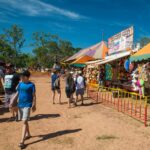We adore fairs, carnivals, and amusement rides, so how could we not love National Merry Go Round Day? Celebrated each year on July 25, this day spotlights the fun ride known as a merry-go-round or carousel. A highlight of amusement parks, these circular rides are still widely popular across America and the globe.
History of National Merry Go Round Day
Merry-go-rounds or carousels are one of the oldest amusement-park rides still in use all over the globe. These little rides have been around for a very long time. Back in the medieval period, European Crusaders returned home after fighting, having adopted a foreign tradition they called ‘little war.’ In a structure they called the ‘carosella,’ people would ride horses holding lances and try to spear a ring hanging overhead from a tree limb. The French called this type of tournament a ‘carrousel.’ This is translated to mean ‘a tilting match’. Used to train knights in medieval times, the style of playing evolved to an extent — knights sat on wooden planks that were suspended from a center post in a circular shape and tried to thrust their lances through a suspended ring.
By the 16th century, French innovation had replaced wooden boards with carved horses suspended from chains. People, mostly noblemen, who were trained this way would sit on the horses, simulating the horse-riding experience without posing the threat of injury to real horses.
It was only in the 17th century that carousels became entertainment. As its popularity expanded, its size reduced. Some played music as the center moved; some were powered by animals while others by humans. Artistic elements to design the merry-go-rounds caught on. Carousel makers grew more innovative with their designs; Michael Dentzel, a German wagon-maker, carved intricate animal figures for merry-go-rounds.
With large-scale immigration to America during this same period, the carousel came to the U.S. While merry-go-rounds were present in the country long before then, they were officially patented and the industry took off. Mass production of carousels boomed with the Industrial Revolution, and they quickly spread around the country. Another benefit of this revolution was the extra leisure time people now had, making relaxation — and so, having fun on a carousel ride, possible.
Steam-power fully replaced animal power in the 19th century, making merry-go-rounds bigger and heavier and creating the initial versions of the current round carousel design. Funfairs made it possible for all classes of people to enjoy these rides. The traditional characters were replaced by popular cartoon characters during this period. Every successful film, cartoon, or comic found its way to the fairgrounds.
By the next century, carousels were being manufactured for amusement parks by many industries. The Great Depression did put a lot of them out of business, except for one — the Philadelphia Toboggan Company. They mainly manufactured roller-coasters; if an amusement park ordered a roller coaster, the company would often add a merry-go-round to the order free of charge. As the Second World War came around, all resources were directed for war efforts, pushing the carousel to the wayside. They rebounded again as the economy improved, and units began to be made from synthetic materials.
A non-profit organization, National Carousel Association, aims to keep carousels running and preserve their history in the United States. They even organize a census, tracking the history of all carousels across the U.S. The President of this association, Bette Largent, along with carousel historian Ronald Hopkins, founded National Merry Go Round Day, to direct attention to the historic carousels still bringing joy to people even today. They especially chose the date, July 25, because it coincides with the day when the first U.S. patent for the modern carousel was given to William Schneider of Davenport, Iowa.
National Merry Go Round Day timeline
A ride in the Byzantine Empire shows riders suspended from a central pole.
Soldiers compete in this game — a version of the current carousel rides, to train for jousting tournaments; this is probably why many carousels have horses.
Mass production of heavy machines used in merry-go-rounds is now possible, so these carousels widen their reach.
It operated in Salem, Massachusetts, and is called a 'wooden horse circus ride.'
Immigrants from European countries bring their love of the carousel with them.
Following the invention of the pedal-powered bicycle, this contraption is found on more carousel rides than on the streets.
William Schneider from Davenport, Iowa patents the very first modern carousel in the U.S.
German master carver and builder of hand-carved carousels and amusement rides, Charles I.D. Looff builds his first carousel, which is in Coney Island.
Steam power replaces animal power, and later in this century, gets replaced by electric power.
Popular cartoons, comics, and film characters are the new carousel decorations and figures.
This non-profit organization runs on donations and aims to keep carousel history alive.
The National Carousel Association's President, Bette Largent, together with carousel historian Ronald Hopkins, founds National Merry-Go-Round Day.
National Merry Go Round Day FAQs
Do you hyphenate merry-go-round?
When you join shorter individual words into one more complicated, compound word, you use a hyphen. So, the word ‘merry-go-round’ uses two of them.
Are carousels and merry-go-rounds the same thing?
While merry-go-rounds are called carousels in America, they are a ride that features no motor, and no horses across the globe, unlike the carousels there.
How fast can a merry-go-round go?
The United States Consumer Product Safety Commission guidelines state that a merry-go-round should not exceed a rotation speed of 13 feet per second.
How To Celebrate National Merry Go Round Day
Sit in one
The National Carousel Association says there are hundreds of registered carousels in America. Chances are, there is one hidden in your neighborhood too. Go ahead, go out, and find one. Maybe introduce the kids in your life to the joys of spinning round and round too.
Read up on carousel history
Visit the National Carousel Association website for more details on their carousel census. Grab reading material from local libraries about famous carousels. Or visit the local carousels and try to find their story. You never know, they might have a life longer than yours and a story that is too interesting not to share!
Watch a carousel-themed movie
Don't feel like stepping out for some carousel-related fun? How about watching a movie instead? You can start with the 1956 romantic musical film “Carousel” — based on a musical of the same name, and move to other amusement park-themed movies. Grab the popcorn and settle in for a fun ride!
5 Fun Facts About Merry Go Rounds
There are songs about it
At least 10 songs are called “Merry-Go-Round;” groups like ABBA, Mötley Crüe, The Replacements, and even Fleetwood Mac have songs featuring this amusement park ride.
Around we go, but in different directions
Merry-go-rounds tend to turn in a clockwise direction in Europe, and counter-clockwise in North America.
Lindbergh used a carousel to 'calm down'
Before crossing the Atlantic in an airplane — and breaking records for being the very first man to do so, Charles Lindbergh rode a Coney Island carousel before the flight to relax.
Ride a carousel for your health
In the early 19th Century, carousels were advertised as 'physician recommended' aids to better circulate blood in the body.
Real horsies?
In the early days, carousel horses were made using real horse hair — mane and/or tail.
Why We Love National Merry Go Round Day
They bring us joy
Merry-go-rounds are a big source of happiness for us; after all, they are a symbol of nostalgia for many people. Even literary depictions show merry-go-rounds as places of magic and adventure. Visit one today, and we promise the music, the atmosphere, and the gentle spins will bring some fun to your day.
They are a symbol of childhood
The last time we let go and had some childish fun was...in childhood. Amusement parks, and the merry-go-round, are an indelible part of everyone's childhood. Celebrating this day takes us back to those playful, carefree days. We love this chance to bring some childish fun to our adult lives.
These rides resemble our lives
They go up and down, spin round and round. Merry-go-rounds resemble life's winding roads greatly. They even mimic the joy of seeing the world whiz by when you are having fun. When the music and the ride stop, we get down happy and relish the memories.
National Merry Go Round Day dates
| Year | Date | Day |
|---|---|---|
| 2025 | July 25 | Friday |
| 2026 | July 25 | Saturday |
| 2027 | July 25 | Sunday |
| 2028 | July 25 | Tuesday |
| 2029 | July 25 | Wednesday |


























